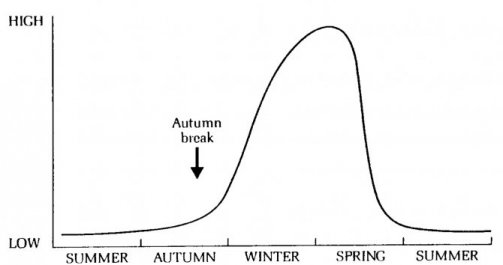Low worm-risk paddocks created by grazing management reduce the pressure from worms at key times, generally resulting in the need for fewer drenches.
For those who like to see all the information and simply read through it in order. Each heading is a link to a page of information—the dot point provides a summary of the page.
Tip: Keep this page open and open the links in new tabs.
Management tools: grazing management
A broad description of the ways in which grazing management can be used.
East coast: Grazing management
Specific grazing management recommendations for this region.
East coast: The life cycle of goat roundworms
A diagram showing the phases in the worm life cycle, plus diagram showing typical time of larval availability in this region.
East coast: Factors contributing to paddock contamination with worms
A table with details of conditions for worm survival on pastures.
For those who prefer a problem based approach to learning, answer the following questions.
Each of the questions below links further down the page to the answers.
Questions:
Answers:
You can also click on each question below to go to WormBoss pages with related information.
1. How long does it take for worm eggs to become infective larvae?
Worm eggs that have passed from the goats in dung hatch and develop through first (L1) and second (L2) larval stages to become infective larvae (L3). The success and speed of this development depends on weather conditions, specifically warmth and moisture, and require a minimum of 4 days and rarely more than 10 days.
2. What temperature and moisture conditions does this development require?
Temperature requirements vary for each worm type, but most require about 15 mm of rain over a few days (but also depends on evaporation rates) to provide sufficient moisture for development. The L3 leave the dung moving onto pasture and soil, rarely more than 25 cm from where they were deposited in the dung.
3. How long do infective larvae live?
Infective larvae are relatively tough and can withstand dry, cold and moderately hot conditions. All populations of living things vary in their life expectancy and worms are no different; some larvae will die within days, but some will live to around a year or more. Generally, over 90% of larvae will be dead within 6 months under cooler conditions and as little as 3 months when temperatures are ideal. Under extremely hot, dry conditions larvae will be desiccated and can die in a few days to weeks of these conditions, explaining why worms are rarely a problem in the arid zone.

Paddocks are considered low worm-risk when over 90% of the worm larvae have died. The graph (right) shows the decline in barber’s pole worm larvae on pasture over time and under different temperature conditions when the relative humidity is 60%.
Paddocks prepared for spring use need 5 or 6 months of preparation, whereas paddocks prepared for summer or autumn use need about 3 months of preparation time.
Source: Modeled from death rate of the L3 population in ‘Simulation of pasture larval populations of Haemonchus contortus’ by IA Barger, PR Benyon & WH Southcott. Proceedings of the Australian Society of Animal Production (1972) 9: 38.
5. About how many eggs are produced per day for barber’s pole worms and black scour worms?
Barber’s pole worms are quite long (20 to 30 mm) and clearly visible. Only adult females have the characteristic ‘barber’s pole’ appearance due to the pink (blood-filled) intestinal tract of the worm twisted around the paler reproductive tract; whereas the males are smaller (around 15 mm) and pale pink. Females are prolific egg layers, laying up to 10,000 eggs per day, as such, higher worm egg counts are usually seen with these worms.
Adult female black scour worms lay 100–200 eggs per day. Black scour worms live in the first three metres of the small intestine of the goat and cause damage to the lining of the gut. The adult female in the small intestine lays eggs, which are passed out in the dung.
6. Aside from leaving a paddock destocked, what are two ways that you could use a paddock while it is being made low worm-risk?
The following practices or a combination of these can create paddocks with less worm contamination and lower worm-risk.
While grazing with cattle is used frequently for preparing safe paddocks for sheep as cattle do not share the same worms, goats are different as they have some worms in common. Notable exceptions are the ability of barber’s pole worm and stomach hairworm (Trichostrongylus axei) to successfully reproduce within goats and young cattle (i.e. pre-weaning). Goats can also be severely infected by brown stomach worms (Ostertagia ostertagi) from cattle, unlike the situation with sheep and lambs. Using dry adult cattle for alternate grazing is preferable, but large benefits still arise from using cows and calves and this should not prevent their use for this purpose.
In barber’s pole regions:
The value of rotational grazing management as an aid for worm control is based on:
and/or
In scour worm regions:
Links to the learning topics for East Coast